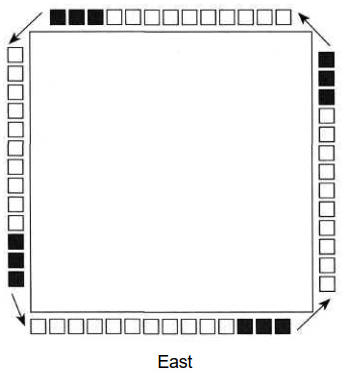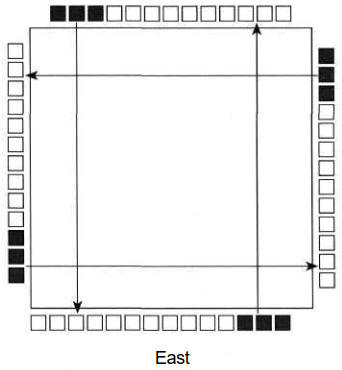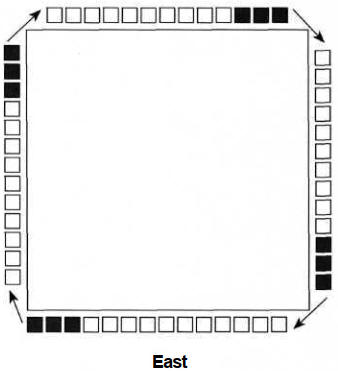
The American game
Jeux
Mah-Jongg
Playing the American Game is basically the same as playing the Chinese Game,
but with the following differences:
(1) Players need an American Mah
Jongg set.
(2) Seats allocation is not required.
(3) Designation of the
first East player is not required.
(4) There is an exchange of unwanted
tiles.
(5) Players can reclaim a Joker tile.
(6) The combination of tiles
of a winning hand is determined by the National Mah Jongg League.
The
American Mahjongg Set
An American Mahjongg set comes with eight Joker
tiles, and four Racks.
The Jokers are wild tiles which can be used to substitute any tiles to make
up a Pung, Kong, Quint or Sextet, except to make up a pair.
Example:

The Racks are for racking the hand of tiles.
Seats Allocation
Seats allocation is not required.
At the beginning of the game, the four players can seat themselves randomly
on four sides of the game table.
Designation of the First East Player
Any player can be the first East player (preferably the host of the
game) to break the wall and to start the game.
Exchange of Unwanted
Tiles
This occurs after each player has picked up 13 tiles (East
player takes 14 tiles)
First Pass
Each player sorts out three unwanted tiles, keeps
them face down, passes them to the player on the right, and adds the three tiles
passed from the player on the left.

Second Pass
Each player sorts out three unwanted tiles, keeps
them face down, passes them to the opposite player and adds the three tiles
passed from the opposite player to his or her hand.

Third Pass
Each player sorts out three unwanted tiles, keeps
them face down, passes them to the player on the left, and add the three tiles
passed by the player on the right to his or her hand.

The first exchange, which is compulsory, is now complete.
Option
Players can perform a second round of exchange by proceeding in the opposite
direction, passing their unwanted tiles to the player on the left at the first
pass, then to the opposite player at the second pass, then to the player on the
right at the third pass.
Blind Pass
During the first round
of exchange, and after the two passes, if a player does not have three unwanted
tiles for the third pass, he or she can take some of the tiles just passed by
the player on the right, without looking at them, add them to his or her
unwanted tiles, and pass the three unwanted files to player on the left.

This is the completion of the second exchange.
Exchange of tiles is
not a meaningful procedure as, during each game, each player will have more than
twenty-five chances to draw a new tile from the wall, and to match it to his or
her hand before discarding an unwanted tile.
But, in the exchange process, a player must FIRST pass the unwanted tiles,
then may receive the same unwanted tiles from another player. In this way, each
player may unintentionally disclose the type of hand he or she is assembling.
Reclaim an Exposed Joker Tile
When a player (including a
player playing a concealed hand) picks up from the wall a matching tile of any
player's exposed Pung, Kong and so on, that includes a Joker tile, that player
can exchange the matching tile for the Joker tile, keep the Joker, and discard
an unwanted tile.
If a player already has an unwanted matching tile, that player must wait until his or her turn to pick up a tile from the wall, then perform the exchange.

Combination of Tiles of Winning Hands
In the American Game, the
combinations of tiles of the winning hands are designed and published by the
National Mah Jongg League, Inc. Each year will differ to some extent from prior
years.
How To Read The Score Card
The tiles of the winning hands are
printed in red, green and blue numbers and letters.
Numbers 1-9 are the numbers of the suit tiles
Red numbers 1-9 are the numbers of character tiles (Craks)

Green numbers 1-9 are the numbers of bamboo tiles (Bams)

Blue numbers 1-9 are the numbers of the circle tiles (Dots)

Letters are abbreviation of the other tiles.
Red D Stands for Red Dragon tile

Green D Stands for
Green Dragon tile

Blue D Stands for
White Dragon (also called Soap) tile

Blue E Stands for
East Wind tile

Blue S Stands for South Wind tile

Blue W Stands for
West Wind tile

Blue N Stands for
North Wind tile

Blue J Stands for
Joker tile

Blue F Stands for
Flower tile

Red X Stands for
exposed hand, a hand with exposed set of tiles
Blue C Stands for
concealed hand, a hand without exposed tiles. You must pick up all the needed
tiles from the wall yourself, including the winning tile.
Pair : Two
identical tiles of any suit and tile

Pung : Three identical tiles of any suit and tile

Kong : Four
identical tiles of any suit and tile

Quint : Five
identical tiles of any suit and tile

Sextet : Six
identical tiles of any suit and tile

The official
standard hands and rules are printed on the card.
Before you purchase a Score Card from The American
Mah-Jongg Association or National Mah Jongg League, you can start playing the
game with the following temporary Score Table (or, you can use the Simple
Version Winning Hand and Score Table from
The people's game and uses
Flower tiles to substitute for Joker tiles)
A winning hand consists of 14
tiles forming any combination of Pair, Pung, Kong, Quint and Sextet.
Start to Play The Game
The game begins with
East player (the dealer who has 14 tiles), who discards a tile face up on the
table and identities the title of the discarded tile, followed by the next
player (to the right) who draws a tile from the wall and makes a discard. Then,
the opposite player draws and discards, followed the player to his or her left,
then back to the Dealer.
To Match a Triplet, Kong, and So On
When a player holds a Pair or a Triplet, that player may claim the identical
tile discarded by any other player to match a Triplet, Kong, and so on.
The player then reveals the set on the table, then discards an unwanted tile to maintain a 13-tile hand.
When a player draws the identical tile, he or she may add it to a revealed or concealed Triplet.
Mismatches
When you make a mistake by
claiming a wrong tile to match a Pung, Kong and so on, you may correct your
error immediately if you have not exposed your matched tiles.
If your matched tiles is exposed and after you have make
a discard, your hand is declared dead. You can continue to pick and discard
throughout the remainder of the game.
Temporary Score Table
These is no Sequence set of tiles in the American Game



Concealed Hand
A hand without exposed tiles. You must pick up 100 points all the needed
tiles from the wall yourself, Jackpot including the winning tile.
Self-drawn winning tile 20 points
Winning Tile
Self-drawn
All players pay the winner double
Discarded
Discarder pays winner Exchange tile The player who performs the exchange for
a Joker tile pays the winner for all players (see section Reclaim an Exposed
Joker Tile)
False Win
When you make a mistake by claiming a
wrong tile to declare a win and displaying your winning hand on the table, you
are penalized by paying the discarder the amount equivalent to the highest value
hand, and paying other players half that amount.
When you self-draw the wrong winning tile, you must pay all players the
amount equivalent to the highest value hand.
Long or
Short Hand (Dai Sheong Kung, Siu Sheong Kung)
A playing hand is either more or less than 13 tiles
If, during a game, a
player finds that his or her playing hand is either more, or less, than 13
tiles, the player is not allowed to discard the excessive tile or to draw a
make-up tile to complete the hand. Instead, he or she must continue to play by
drawing and discarding tiles as usual until the game is over.
This player must be careful in discarding tiles. To avoid losing to a high-scoring hand, he or she should discard only nonmatching tiles to other players, in the hope that no opponent will win the game by claiming one of the discards.
Fortune Hand - a Draw (Wong Pai)
When only seven stacks (14 tiles) are left on the wall, with none of the players being able to complete a winning hand, the game is considered a draw. This is called a Fortune Hand because there is no loser. The same Dealer will continue for the next game.
Five-Player Game - Dreaming (Dar Mung)
Mah jongg is normally a four-player game, but five players can play it by rotation. During the allotment of seats at the beginning of the game, a No. 5 Circle tile is added to the four Wind tiles to make a five-tile stack.
The four players who pick the Wind tiles will start the game.
The person who picks the No. 5 Circle tile must wait an entire round before he or she can participate. Since the fifth player has little to do, he or she is aptly called a Dreamer.
At the end of the first round (East Wind Round), the First Dealer retires and is replaced by the fifth player, the Dreamer. The retired First Dealer becomes a Dreamer for the second round.
At the end of this round (South Wind Round), the South player is replaced by the First Dealer. The game continues until five rounds have been reached, with each player having participated in four of the five. If desired, the game can continue uninterrupted by repeating the same procedure.
The seat reallotment is not required after each five-round cycle.
Three-Player Game (Dar Sam Yan Pai)
The game can be played as well in the absence of one player, by removing any one suit of the tiles from the set.
However, when casting the dice to designate the First Dealer and to break the walls in each game, if the count ends at the absentee player, the dice must be cast again.
